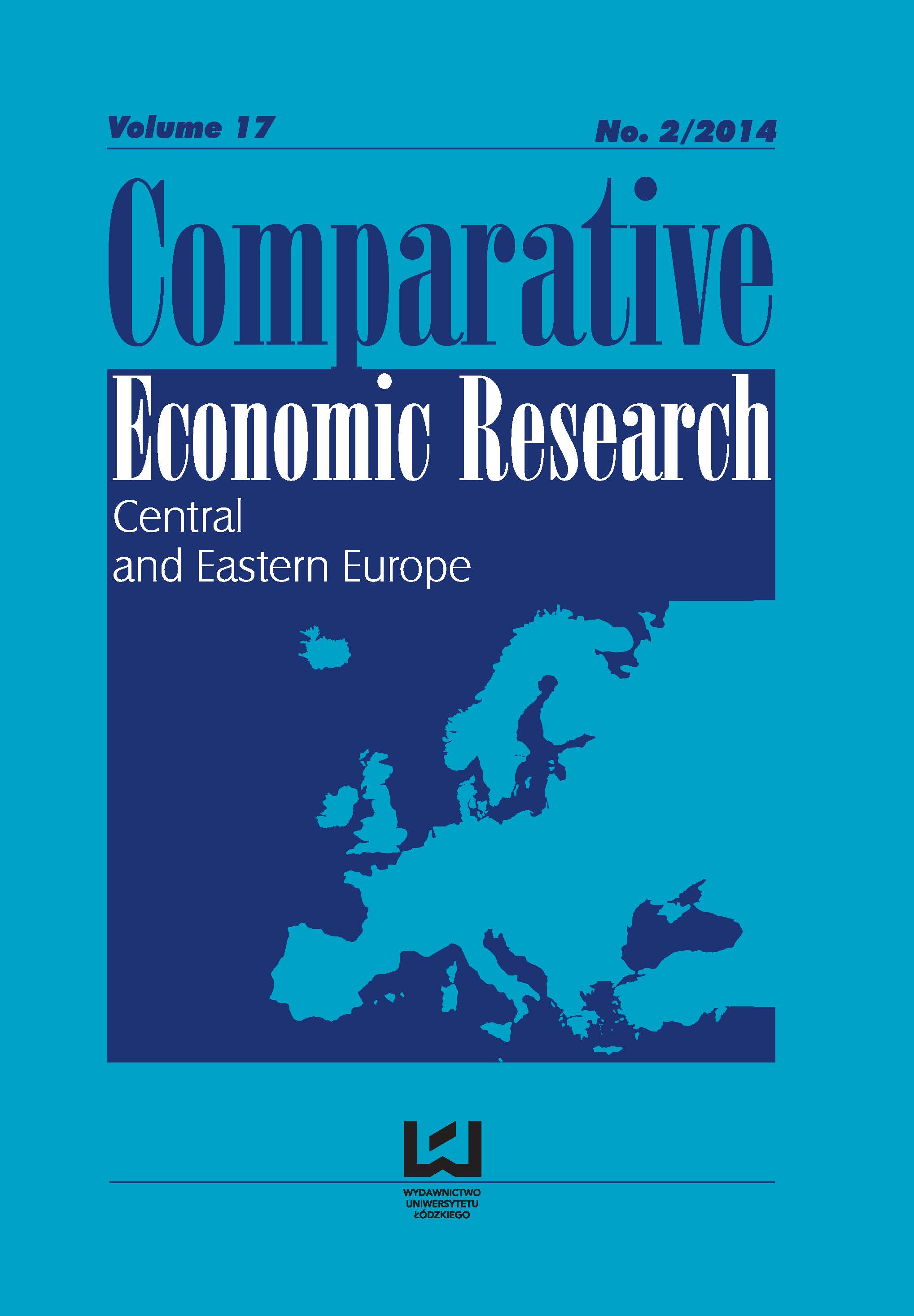Changing Patterns in the Export of Goods Versus International Competitiveness. A Comparative Analysis for Central-East European Countries in the Period 2000–2011
DOI:
https://doi.org/10.2478/cer-2014-0014Keywords:
competitiveness, export, technology-intensity, comparative analysisAbstract
This paper discusses the existing links between changing patterns in the export of goods, broken down by technology-intensity, versus intrenational competitiveness. The study covers nine Central-East European (CEE) economies: Bulgaria, the Czech Republic, Estonia, Hungary, Latvia, Lithuania, Poland, Romania and the Slovak Republic, in the time span 2000-2011. We examine the hypothesis of a strong, positive and statistically significant relationship between flows of export of high-tech and ICT manufactures industries goods, and an economy’s level of international competitiveness (approximated by the Global Competitiveness Index - GCI, see: World Economic Forum). Our methodological approach relies on elaboration of each country`s individual export patterns with regard to industries of different technology-intensities, and statistical analysis between the international GCI variable and variables identifying shares in total export of certain industries. Contrary to what was initially expected, our empirical results do not seem to support the hypothesis on statistically positive links between growing shares of high-tech and ICT manufactures industries in the total value of export versus the Global Competitiveness Index in the analyzed countries.
Downloads
References
Arrow, Kenneth J. (1962), Economic Welfare and the Allocation of Resources to Invention, The Rand Corporation, United States
Google Scholar
Aiginger, K. (2006), Competitiveness: From a Dangerous Obsession to a Welfare Creating Ability with Positive Externalities, ‘Journal of Industry, Competition and Trade’, Springer, 6 (2)
Google Scholar
Alcalá, F. and Ciccone, A. (2004), Trade and Productivity, ‘Quarterly Journal of Economics’, Oxford Journals, 119 (2)
Google Scholar
Amable, B., Verspagen, B. (1995), The role of technology in market shares dynamics, Open Access publications from Maastricht University, Maastricht, no. 27-18070
Google Scholar
Bernard, A., J. Jensen, S. Redding and P. Schott. (2007), Firms in International Trade, Journal of Economic Perspectives, American Economic Association, 21(3)
Google Scholar
Cantwell, J. (1989), Technological Innovation and Multinational Corporations, B.Blackwell Publishing
Google Scholar
Carolyn, F. (2001), Rebating environmental policy revenues: output-based allocation and tradable performance standards, Discussion Chapters db-01-22, Resources for the Future, 01-22
Google Scholar
Chesnais, F. (1992), National Systems of Innovation, Foreign Direct Investment and the Operations of Multinational Enterprises, in Lundvall, B. A. (ed) National Systems of Innovation, Pinter Publishers: London
Google Scholar
Delgado M., Ketels C., Porter M., Stern S. (2012), The determinants of national competitiveness, Working Paper 18249, National Bureau Of Economic Research, United States
Google Scholar
Delgado, M. and C. Ketels. (2011), Assessing Country Competitiveness: Case of Spain, in P.Cooke, J.L. Curbelo and M.D. Parrilli (eds.) Innovation, Global Change and Territorial Resilience, Edward Elgar, Cheltenham
Google Scholar
Dollar, D. and A. Kraay. (2003), Institutions, Trade, and Growth, Journal of Monetary, Economics, Elsevier, 50 (1)
Google Scholar
Dosi, G., K.L.R. Pavitt and L.L.G. Soete, (1990), The Economics of Technical Change and International Trade, Harvester Wheatsheaf, Hemel Hempstead
Google Scholar
Dunning, J.H. (1993), Multinational Enterprises and the Global Economy, Wokingham, Berks: Addison-Wesley
Google Scholar
Fagerberg, J., M. Srholec and M. Knell. (2007), The Competitiveness of Nations: Why Some Countries Prosper While Others Fall Behind, World Development, Elsevier, 35 (10)
Google Scholar
Fagerberg, J. (1989), Innovation, catching-up and growth, Working Chapter 1989137, Centre for Technology, Innovation and Culture, University of Olso
Google Scholar
Hatzichronoglou, T. (1997), Revision of the high-technology sector and product classification, OECD Science, Technology and Industry Working Chapter 1997/02, OECD
Google Scholar
Hausmann, R. and B. Klinger. (2006), Structural Transformation and Patterns of Comparative Advantage in the Product Space, Working Paper No. 128.Cambridge, MA: Harvard University Center for International Development
Google Scholar
Krugman P. (1994), Competitiveness – a dangerous obsession, Foreign Affairs. Issue: March/April 1994 (volume 73, number 2)
Google Scholar
Lall, S. (2000), The technological structure and performance of developing country manufactured exports, 1985-98, Oxford Development Studies, Oxford, vol. 28(3)
Google Scholar
Lall, S. (2001), Competitiveness, Technology and Skills. Edgar Elgar, Cheltenham
Google Scholar
Leontief, W. (1953), Domestic production and foreign trade; the American position re-examined, Proceedings of the American Philosophical Society, American Philosophical Society, Vol. 97, No.4
Google Scholar
Lopez, R.A. (2005), Trade and growth: reconciling the international and microeconomic evidence, Journal of Economic Surveys, Wiley Blackwell, vol. 19(4)
Google Scholar
MacGarvie, M. (2006), Do firms learn from international trade?, Review of Economics and Statistics, MIT Press, 88 (1)
Google Scholar
Narula, R. (1993), Technology, international business and Porter`s diamond: synthesising a dynamic competitive development model, Management International Review, Springer, special issue, vol. 2
Google Scholar
Nicoletti, G., Scarpatta S. (2003), Regulation, Productivity and Growth, OECD Working Paper, OECD, No. 347
Google Scholar
Porter, M. E. (2006), The Microeconomic Foundations of Prosperity: Findings from the Business Competitiveness Index, with C. Ketels and M. Delgado, in World Economic Forum (ed.), Global Competitiveness Report 2006-2007, Geneva: World Economic Forum
Google Scholar
Porter, M.E., M. Delgado, C. Ketels, and S. Stern. (2008), Moving to a New Global Competitiveness Index, in World Economic Forum (ed.), 2008, The Global Competitiveness Report 2008-2009
Google Scholar
Posner, M.V. (1961), International Trade and Technical Change, Oxford Economic Chapters, Oxford, 13
Google Scholar
Rodríguez, F. and D. Rodrik. (2000), Trade Policy and Economic Growth: A Skeptic's Guide to the Cross-National Evidence, in B. Bernanke and K. Rogoff (eds.), NBER Internationals Annual 2000. Cambridge, MA: National Bureau of Economic Research
Google Scholar
Roztocki N., Weistroffer, H.R. (2008), Information Technology in transition economies, Journal of Global Information Technology Management, Ivy League Publishing, Vol.11, No.4
Google Scholar
Spencer, B. and J. Brandner. (2008), Strategic Trade Policy, in: The New Palgrave Dictionary of Economics, ed. by S.N. Durlauf and L. E. Blume, Basingstoke, Hampshire: Palgrave Macmillan
Google Scholar
Trabold, H. (1995), Die internationale Wettbewerbsfähigkeit einer Volkswirtschaft, DIW- Vierteljahresheft, Berlin, No. 2
Google Scholar
Wood, A. (1994), Give Heckscher and Ohlin a Chance!, Weltwirtschaftliches Archiv, Kiel, Vol. 130(1)
Google Scholar
Downloads
Published
How to Cite
Issue
Section
License

This work is licensed under a Creative Commons Attribution-NonCommercial-NoDerivatives 4.0 International License.











